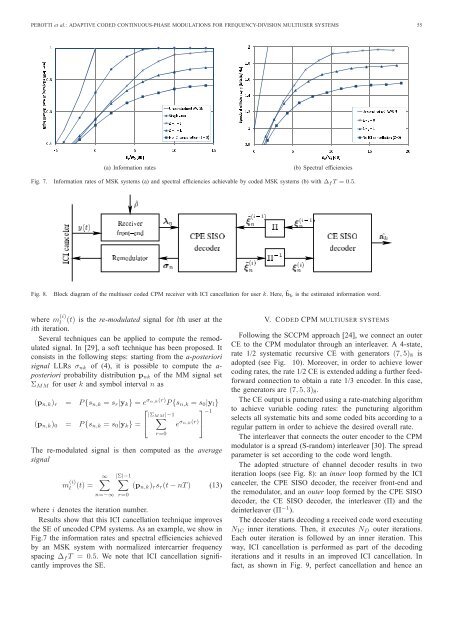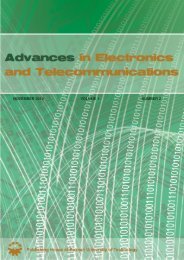channel - Advances in Electronics and Telecommunications
channel - Advances in Electronics and Telecommunications
channel - Advances in Electronics and Telecommunications
Create successful ePaper yourself
Turn your PDF publications into a flip-book with our unique Google optimized e-Paper software.
PEROTTI et al.: ADAPTIVE CODED CONTINUOUS-PHASE MODULATIONS FOR FREQUENCY-DIVISION MULTIUSER SYSTEMS 55<br />
(a) Information rates (b) Spectral efficiencies<br />
Fig. 7. Information rates of MSK systems (a) <strong>and</strong> spectral efficiencies achievable by coded MSK systems (b) with ∆f T = 0.5.<br />
Fig. 8. Block diagram of the multiuser coded CPM receiver with ICI cancellation for user k. Here, ˆbk is the estimated <strong>in</strong>formation word.<br />
where m (i)<br />
(t) is the re-modulated signal for lth user at the<br />
l<br />
ith iteration.<br />
Several techniques can be applied to compute the remodulated<br />
signal. In [29], a soft technique has been proposed. It<br />
consists <strong>in</strong> the follow<strong>in</strong>g steps: start<strong>in</strong>g from the a-posteriori<br />
signal LLRs σnk of (4), it is possible to compute the aposteriori<br />
probability distribution pnk of the MM signal set<br />
ΣMM for user k <strong>and</strong> symbol <strong>in</strong>terval n as<br />
(pn,k)r = P {sn,k = sr|yk} = e σn,k(r)<br />
P {sn,k = s0|yl}<br />
⎡<br />
⎤−1<br />
|ΣMM |−1<br />
(pn,k)0 = P {sn,k = s0|yk} = ⎣<br />
�<br />
r=0<br />
e σn,k(r) ⎦<br />
The re-modulated signal is then computed as the average<br />
signal<br />
m (i)<br />
l (t) =<br />
∞�<br />
n=−∞<br />
|Σ|−1 �<br />
r=0<br />
(pn,k)rsr(t − nT ) (13)<br />
where i denotes the iteration number.<br />
Results show that this ICI cancellation technique improves<br />
the SE of uncoded CPM systems. As an example, we show <strong>in</strong><br />
Fig.7 the <strong>in</strong>formation rates <strong>and</strong> spectral efficiencies achieved<br />
by an MSK system with normalized <strong>in</strong>tercarrier frequency<br />
spac<strong>in</strong>g ∆f T = 0.5. We note that ICI cancellation significantly<br />
improves the SE.<br />
V. CODED CPM MULTIUSER SYSTEMS<br />
Follow<strong>in</strong>g the SCCPM approach [24], we connect an outer<br />
CE to the CPM modulator through an <strong>in</strong>terleaver. A 4-state,<br />
rate 1/2 systematic recursive CE with generators (7, 5)8 is<br />
adopted (see Fig. 10). Moreover, <strong>in</strong> order to achieve lower<br />
cod<strong>in</strong>g rates, the rate 1/2 CE is extended add<strong>in</strong>g a further feedforward<br />
connection to obta<strong>in</strong> a rate 1/3 encoder. In this case,<br />
the generators are (7, 5, 3)8.<br />
The CE output is punctured us<strong>in</strong>g a rate-match<strong>in</strong>g algorithm<br />
to achieve variable cod<strong>in</strong>g rates: the punctur<strong>in</strong>g algorithm<br />
selects all systematic bits <strong>and</strong> some coded bits accord<strong>in</strong>g to a<br />
regular pattern <strong>in</strong> order to achieve the desired overall rate.<br />
The <strong>in</strong>terleaver that connects the outer encoder to the CPM<br />
modulator is a spread (S-r<strong>and</strong>om) <strong>in</strong>terleaver [30]. The spread<br />
parameter is set accord<strong>in</strong>g to the code word length.<br />
The adopted structure of <strong>channel</strong> decoder results <strong>in</strong> two<br />
iteration loops (see Fig. 8): an <strong>in</strong>ner loop formed by the ICI<br />
canceler, the CPE SISO decoder, the receiver front-end <strong>and</strong><br />
the remodulator, <strong>and</strong> an outer loop formed by the CPE SISO<br />
decoder, the CE SISO decoder, the <strong>in</strong>terleaver (Π) <strong>and</strong> the<br />
de<strong>in</strong>terleaver (Π −1 ).<br />
The decoder starts decod<strong>in</strong>g a received code word execut<strong>in</strong>g<br />
NIC <strong>in</strong>ner iterations. Then, it executes ND outer iterations.<br />
Each outer iteration is followed by an <strong>in</strong>ner iteration. This<br />
way, ICI cancellation is performed as part of the decod<strong>in</strong>g<br />
iterations <strong>and</strong> it results <strong>in</strong> an improved ICI cancellation. In<br />
fact, as shown <strong>in</strong> Fig. 9, perfect cancellation <strong>and</strong> hence an







